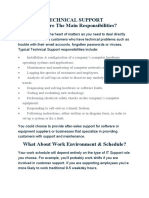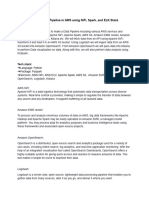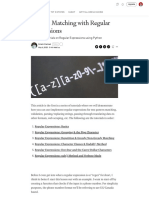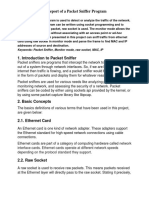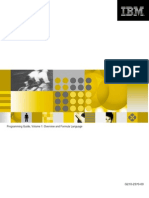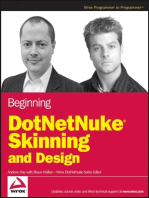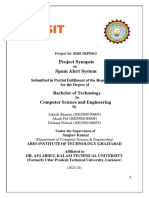User and Task Analysis For Interface Design PDF
Uploaded by
GaganUser and Task Analysis For Interface Design PDF
Uploaded by
GaganPublications
User and Task Analysis for Interface Design
JoAnn T. Hackos and Janice C. Redish
Review by Larry E. Wood and Brigham Young University
As indicated in the preface to the book, jobs, tasks, and tools they use). The order to gather the data that are neces-
the authors' purpose is to introduce authors are careful to point out how sary to provide that understanding.
techniques of user and tasks analysis important it is to consider individual
so that folks ranging from software differences in personal, physical, cul- In part 2 (Getting Ready for Site Vis-
designers to technical communicators tural and motivational characteristics its), the authors provide chapters on
can use them to inform their design among a set of heterogeneous. The the selection of techniques most
activities. The authors do a masterful authors make the point that some char- appropriate to a particular project,
job of bringing together a variety of acteristics can lead to conflicting consideration of users environments
techniques and methods, sprinkled lib- design demands, which will require (chapter six), the arrangement of the
erally with guidance in their use. That compromises in the final design. details of the site visit with the users
guidance is tempered by their many and others at the site (chapter seven),
years of experience of project devel- Chapter three provides valuable back- and the preparation and organization
opment with users in a wide variety of ground regarding the analysis of users' of the team conducting the visit (chap-
contexts. Throughout the book, the work that is to be supported by an ter eight). As implied, these chapters
authors reflect an attitude that there is application. The authors discuss the provide helpful details regarding the
no correct way to do things in every notion of task analysis in some depth, importance of planning and organizing
situation, and they make every effort beginning with the importance of visits to provide the most benefits.
to point out the conditions under keeping in mind the users' goals. The Drawing on the old adage, “The best
which various methods and techniques authors then review the importance of laid plans of mice and men ofttimes go
tend to be more or less effective. Thus, the broader context of workflow and astray”, Hackos and Redish do a thor-
their intent is to inform readers, and to other aspects of the users' jobs. ough job of discussing the many
provide them with the knowledge and Because task analyses requires docu- details involved in choosing the most
techniques to make appropriate deci- mentation, the authors review several appropriate techniques and the most
sions. alternatives for representing the results appropriate participants for collecting
(e.g., task hierarchies, flow diagrams). the most appropriate data during the
Following the introductory chapter, Finally, the reader is informed of the visit.
the book is organized in four parts. In need to be interpret results in light of
part 1 (Understanding the Context of the experience of the potential users, In the final chapter of the section, the
User and Task Analysis), individual ranging from novice to experts. authors get down to the nitty-gritty of
chapters are dedicated to the impor- making certain that the visit will yield
tance of understanding the characteris- In chapter four, the authors call atten- all that it can. They discuss details
tics of potential users, their tasks, and tion to a variety of issues regarding the ranging from the appropriate dress to
their environments. Chapter 1 makes user's environment. They provide forms that will insure that all relevant
an effective case for the importance of some interesting examples of the kinds information is captured in one way or
learning about users and their tasks of grave consequences that await those another. It is easy to get caught up in
that an application is being design to who neglect to consider not only concerns about what information
support. There is also a short section issues in the physical environment, but could be gathered at the expense
listing the objections that are often the social and cultural aspects as well. (oddly enough) of what really ought to
voiced about why companies often be gathered.
neglect or avoid making the effort to Those usability specialists still strug-
perform user and task analyses. gling to get “respect” in their compa- Part three (Conducting the Site Visit)
nies will find chapter five particularly contains valuable information on tech-
In chapter two, the reader is instructed useful because is contains valuable niques and skills for interacting with
in the generation of user profiles from information to assist HCI workers in potential users through observation
various categories of information making a business case to company and interviewing. Chapter 9 is devoted
relating to the ways in which the users management for providing the to a discussion of observation tech-
define themselves and their roles (e.g., resources necessary to do site visits in niques, with an emphasis on goal-ori-
SIGCHI Bulletin Volume 31, Number 3 July 1999 19
ented user task analysis and the discussed in chapter twelve, Here the initely an excellent source for anyone
documentation of observations to authors suggest that the design begin interested in an introduction to the
make the results useful for later stages with a consideration of usability goals field of User-Centered Design. I found
of development. Throughout this sec- and measurable objectives, and from it to be an excellent text for my user-
tion, readers are cautioned about the there they move to the development of centered design course. The only neg-
natural tendency for observers to let a metaphor and use scenarios and ative comment I received from stu-
their biases color their interpretations work flows. The next step is to begin dents was that some of the graphics
of observations. forming the design, using storyboard- seem a bit gratuitous (a picture of a
ing, sketching, and video presenta- group of people carrying suit cases is
Interviewing skills are discussed in tions. That discussion leads naturally used to illustrate the point that users
chapter 10, where the authors empha- into a description of prototyping meth- “carry a lot of baggage” that affects the
size the importance of listening to the ods and techniques for their evaluation way they learn).
interviewees with an open mind, with in chapter thirteen.
the attitude that the usability specialist User and Task Analysis for Interface
is there to learn from them, rather than The final chapter of the book provides Design
to confirm the specialist's expecta- an extensive discussion of documenta- by JoAnn T. Hackos and Janice C.
tions. The authors review extensively tion and training, beginning with the Redish
the various types of questions (e.g., role of task and user analysis as it
applies to those activities. The presen- Publication date: 1997
open vs. closed) and the need to ask
neutral rather than loaded or leading tation includes the development of ISBN: 0-471-17831-4
questions. hard copy help and training materials Published by: John Wiley &Sons, Inc.
as well as on-line help and computer-
Part four (Making the Transition from based training, including a brief con-
Analysis to Design) discusses how the sideration of the “Web”. About the Reviewer
information gathered in the site visits
is used to produce an interface design. In summary, Hackos and Redish pro- Larry Wood
Chapter 11 deals with methods for vide a comprehensive discussion of WoodL@byu.edu
analyzing the data from site visits by User-Centered Design that is very
first creating representations such as readable and understandable. The
workflows, task hierarchies, and task book is well organized from both glo- Larry Wood is currently a Professor of
scenarios, and then reorganizing those bal and local (each chapter) perspec- Psychology at Brigham Young Uni-
results using such techniques as affin- tives. In addition, the book is sprinkled versity. He has conducted research and
ity diagrams and insight sheets to clar- liberally with examples from the taught courses in User-Centered
ify relationships. authors' own work (as well as others') Design for fifteen years. He is editor of
on real world projects. At the end of User Interface Design: Bridging the
Using the results of the analysis to each chapter there is a list of other Gap from User Requirements to
begin designing an interface design is sources relevant information. It is def- Design (CRC Press, 1998).
20 July 1999 Volume 31, Number 3 SIGCHI Bulletin
You might also like
- The MVS 3.8j Tur (N) Key 4-System: User's ManualNo ratings yetThe MVS 3.8j Tur (N) Key 4-System: User's Manual28 pages
- Packet and Flow Based Network Intrusion DatasetNo ratings yetPacket and Flow Based Network Intrusion Dataset12 pages
- Technical Support What Are The Main Responsibilities?No ratings yetTechnical Support What Are The Main Responsibilities?6 pages
- Validate XML Against An XSD Using Notepad++No ratings yetValidate XML Against An XSD Using Notepad++5 pages
- Software Development Process - Software Quality Process - Software Support ProcessNo ratings yetSoftware Development Process - Software Quality Process - Software Support Process23 pages
- Research Paper On Foreign Exchange Market in India: Name Roll NoNo ratings yetResearch Paper On Foreign Exchange Market in India: Name Roll No21 pages
- Worlds Largest Centralized Core Processing Implementation SBI IT StrategyNo ratings yetWorlds Largest Centralized Core Processing Implementation SBI IT Strategy17 pages
- High Performance Trading - FIX Messaging Testing For Low LatencyNo ratings yetHigh Performance Trading - FIX Messaging Testing For Low Latency24 pages
- APB Standard Operating ProcedurebvbvbvbvbNo ratings yetAPB Standard Operating Procedurebvbvbvbvb26 pages
- Network Monitoring and Analysis by Packet Sniffing MethodNo ratings yetNetwork Monitoring and Analysis by Packet Sniffing Method3 pages
- Rbi Structure and Function Subsidiaries of Rbi Final 83No ratings yetRbi Structure and Function Subsidiaries of Rbi Final 834 pages
- Installing Standalone MQ Explorer 9.3 in Windows and Linux_5No ratings yetInstalling Standalone MQ Explorer 9.3 in Windows and Linux_525 pages
- 5.4.3.4 Lab - Use Wireshark To Compare Telnet and SSH Traffic-SAPARUDDINNo ratings yet5.4.3.4 Lab - Use Wireshark To Compare Telnet and SSH Traffic-SAPARUDDIN5 pages
- Pattern Matching With Regular Expressions - by Zohaib Shahzad - The Startup - MediumNo ratings yetPattern Matching With Regular Expressions - by Zohaib Shahzad - The Startup - Medium8 pages
- Java (Networking) (Jpcap: Capturing and Displaying Packet Traffic With Jpcapcapturepacket and Receivepacket)No ratings yetJava (Networking) (Jpcap: Capturing and Displaying Packet Traffic With Jpcapcapturepacket and Receivepacket)3 pages
- Blackbook Project On Money Market 163426No ratings yetBlackbook Project On Money Market 16342667 pages
- Extracting Data From Lotus Notes and DominoNo ratings yetExtracting Data From Lotus Notes and Domino20 pages
- Installing MQ 9.3, Applying Fix Pack 9.3.0.5, Uninstalling in Linux RHEL100% (1)Installing MQ 9.3, Applying Fix Pack 9.3.0.5, Uninstalling in Linux RHEL31 pages
- CN 422-Week#3 Lect-Packet Capture and AnalysisNo ratings yetCN 422-Week#3 Lect-Packet Capture and Analysis31 pages
- Lotus-Domino-Designer Programming Guide Vol1100% (1)Lotus-Domino-Designer Programming Guide Vol1693 pages
- Project - Software Engineering TechniquesNo ratings yetProject - Software Engineering Techniques141 pages
- Unit-3 Software: Need of Computer SoftwareNo ratings yetUnit-3 Software: Need of Computer Software10 pages
- Professional Summary:: Bhavana Pallepati Software Engineer 404-860-3320No ratings yetProfessional Summary:: Bhavana Pallepati Software Engineer 404-860-33206 pages
- Software Requirement Specifications: Nashtech Page 1 of 28 Offshore Software DevelopmentNo ratings yetSoftware Requirement Specifications: Nashtech Page 1 of 28 Offshore Software Development27 pages
- Construction of A Benchmark For The User Experience Questionnaire (UEQ)No ratings yetConstruction of A Benchmark For The User Experience Questionnaire (UEQ)6 pages
- Workforce Optimization Suite: Avaya - CSI For CMS Report Interface GuideNo ratings yetWorkforce Optimization Suite: Avaya - CSI For CMS Report Interface Guide24 pages
- Generating Operating Procedures For Chemical Process PlantsNo ratings yetGenerating Operating Procedures For Chemical Process Plants32 pages
- Web-Based Thesis Capstone Project Defense Evaluation System of The CCS BiñanNo ratings yetWeb-Based Thesis Capstone Project Defense Evaluation System of The CCS Biñan17 pages
- Curriculam Vitae Chaitali Jain: Career ObjectiveNo ratings yetCurriculam Vitae Chaitali Jain: Career Objective2 pages
- Investigation of Pedestrian Safety Problems and Its CountermeasuresNo ratings yetInvestigation of Pedestrian Safety Problems and Its Countermeasures8 pages
- 2020CSEPID63 - Spam Alert System Synopsis FinalNo ratings yet2020CSEPID63 - Spam Alert System Synopsis Final12 pages
- The Impact of Assistive Technology On CommunicationNo ratings yetThe Impact of Assistive Technology On Communication14 pages
- Best of The Web Comscore Analysis of Best Practices Among Government WebsitesNo ratings yetBest of The Web Comscore Analysis of Best Practices Among Government Websites26 pages







